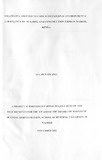| dc.description.abstract | I he alignment between strategy and environment lies at the centre of strategic management. Since the turn of the millennium, the general business environment has become more \olatile. unpredictable and very competitive. This study sought to determine the strategies adopted by building and construction firms in Kenya to cope with external environmental turbulences with reference to construction companies in Nairobi. The study also sought to determine the strategies adopted by building and construction firms in Nairobi. Kenya to cope with external environmental turbulences and to identify the challenges facing building and construction firms operating in turbulent environmental conditions in Nairobi, Kenya.
A descriptive cross-sectional design method was preferred for this study as it offered the researcher the methodology to investigate the strategies adopted by building and construction firms in Kenya to cope with external environmental turbulences. The target population was the building and construction firms in Nairobi as derived from the latest list of the Ministry of Works government approved contractors. The most current listing of March 2012 has a total of 6644 contractors with 4063 of them based in Nairobi County. Stratified proportionate random sampling technique was used to select a sample of 64 respondents by taking eight companies from each of the eight categories of construction companies. Alter collecting data responses from the questionnaire, the researcher analyzed the quantitative data using descriptive statistics and presented it through percentages, means, standard deviations and frequencies. The qualitative data was coded thematically and then analyzed statistically.
The study established that the strategies adopted to a great extent to cope with external environmental turbulences are financing strategy (for example, debt rescheduling, raising equity, business strategy (cost focus, differentiation or hybrid), growth strategy (consolidation, withdrawal. launching ncw: products, entering new markets) and portfolio strategy (divestment, acquisition, alliance, new product development. This study therefore recommends that the institutions charged with the responsibility of licensing and monitoring new and existing firms to regulate the entry of new firms to avoid unhealthy competition and deliver quality work. | en_US |



